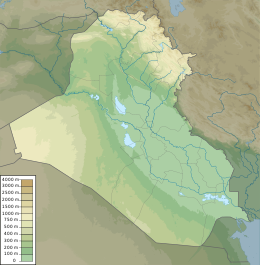 | |
| Continent | Asia |
|---|---|
| Region | Middle East |
| Coordinates | 33 00 N, 44 00 E |
| Area | Ranked 60 |
| • Total | 438,317 km2 (169,235 sq mi) |
| Coastline | 58 km (36 mi) |
| Borders | Turkey to the north, Iran to the east, the Persian Gulf and Kuwait to the southeast, Saudi Arabia to the south, Jordan to the southwest, and Syria to the west. |
| Highest point | Cheekha Dar 3,611 m (11,847 ft) |
| Lowest point | Persian Gulf 0 m (0.0 ft) |
| Longest river | Euphrates |
| Largest lake | Lake Tharthar |
| Natural resources | Petroleum, sulfur, phosphate, and natural gas.[1] |
In Iraq, climate change has led to environmental impacts such as increasing temperatures, decreasing precipitation, land degradation, and water scarcity.[2] Climate change poses numerous risks to human health, livelihoods, political stability, and the sustainable development of the nation.[2] The combination of ecological factors, conflict, weak governance, and an impeded capacity to mitigate climate change, has made Iraq uniquely at risk to the negative effects of climate change, with the UN ranking them the 5th most vulnerable country to climate change.[3] Rising temperatures, intensified droughts, declining precipitation, desertification, salinization, and the increasing prevalence of dust storms are challenges Iraq faces due in to the negative impacts of climate change. National and regional political instability and conflict have made it difficult to mitigate the effects of climate change, address transnational water management, and develop sustainably.[2] Climate change has negatively impacted Iraq's population through loss of economic opportunity, food insecurity, water scarcity, and displacement.
Water-related challenges are at the forefront of Iraq's environmental problems. Models predict that precipitation will decrease by 9% and mean annual temperatures will increase by 2°C by 2050.[4] The flow of the Tigris and Euphrates rivers, which provide 98% of Iraq's surface water, has decreased by 30-40% in the past 40 years.[5] The water resources of these two rivers are also shared with neighboring countries. Iraq's water supplies have significantly decreased over time due to dam construction from upstream nations.[6]
In 2019 Iraq contributed 0.5% to global carbon emissions.[7] Iraq's energy sector and fugitive emissions account for three-fourths of the nation's emissions.[7] Specifically, Iraq's oil and gas sectors produced 9% of global methane emissions in 2019, a portion of which is from gas flares.[2] The waste, industrial, and agriculture sectors are the other sectors contributing to Iraq's greenhouse gas emissions.
Iraq produced an Intended Nationally Determined Contribution (INDC), which is a set of policies and goals for how Iraq can address climate change. Iraq wants to reduce emissions by 15% by 2035, with a specific focus on lowering their methane emissions.[8] Iraq ratified the Paris Treaty in 2021 and committed to specific actions to reduce methane emissions in the oil and gas sector, which are coordinated by a newly established inter-ministerial national task force on methane emissions.[9]
- ^ "Natural Resources of Iraq". WorldAtlas. 2019-07-24. Retrieved 2024-04-29.
- ^ a b c d "Climate change is the biggest threat Iraq has ever faced, but there is hope to turn things around". unsdg.un.org. Retrieved 2023-11-11.
- ^ Wehrey, Frederic Wehrey (July 6, 2023). "Climate Change and Vulnerability in the Middle East". Carnegie Endowment for International Peace.
- ^ "Climate Risk Profile: Iraq". www.climatelinks.org. 2017-03-03. Retrieved 2023-11-15.
- ^ Hall, Natasha (2023-12-05). "Local to Global: Tensions Course through Iraq's Waterways". Center for Strategic and International Studies.
- ^ Bruneau, Charlotte; Al-sudani, Thaier (2021-10-14). "'Our whole life depends on water': Climate change, pollution and dams threaten Iraq's Marsh Arabs". Reuters. Retrieved 2023-12-03.
- ^ a b "Iraq Country Climate and Development Report". World Bank. Retrieved 2023-11-15.
- ^ Cite error: The named reference
www.ccacoalition.orgwas invoked but never defined (see the help page). - ^ "As Iraq joins Paris Agreement, UN calls for further support to help the country adapt". iraq.un.org.